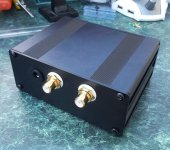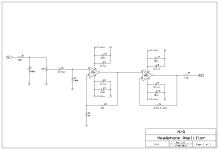Uh... since I started this I've spent £255 at mouser, £85 at farnell and another ~£300 at Amazon/ebay/similar - that does include buying new soldering and testing equipment, cables and stuff for the USB DAC side as well. (I had a pretty decent payout to work the recent bank holidays/additional overtime so not been too careful with costs).
Quite liking this latest circuit from listening to various sources including FLAC from originally recorded sources I think most of the issues I'm hearing are compression artefacts in MP3s, etc. though need a bit more testing yet - it certainly has a lot of positives - clarity, lifelike note to instruments, very decent bass, but some stuff I'm not sure on.
Quick run down on it:
As before the virtual ground is based on goldpoint's regulated one here:
http://www.head-fi.org/t/654485/virtual-ground-regulated-and-rail-splitter-circuits (1085 + 317/336/337 version) this is pretty much essential to get these particular op amps properly stable.
All caps in the power supply stage are Panasonic FM series (if your using battery power then Nichicon KW series will give a warmer sound if thats your thing but don't clean up anything like as good as the FMs if your using a DC adapter).
The big caps are all 470uf (bigger better if you have space for it but don't go below 470), the rest 22uf as per the original design.
I'm using 15v into the 1085 with 220/2.2K resistors on the adjust circuit and 2.8K on the divider givingly slightly less than 7v per rail.
The gain stage is based off the tried and tested cmoy:
http://tangentsoft.net/audio/cmoy/
The audio input capacitors are Nichicon 0.47uf polypropylene film caps.
I'm using 0.1uf ceramic and 10uf Nichicon FG series bypass on both the + and - op amp supply pins (the Nichicons seem to offset the slight hardening of the sound from the ceramics) for both the gain op amp and the buffer op amp.
The gain stage op amp is an OPA2228P (not PA though it doesn't make much odds) with 10K and 2K resistors in the feedback loop for a gain of 6 (it won't be properly stable much under that).
The AD8066 is hanging off the 2228's outputs as a unity gain buffer stage using a simple feedback loop with just a 22 ohm resistor in the loop and 47 ohm resistors on its outputs - the feedback loop branches before the 47 ohm resistors.
EDIT: Think I'm sold on this setup - do lose a tiny bit of the 8066's bass and sound stage but trade off is overall more airy sound without the veiled signature of the 8066 and even more lifelike instruments than the 8066 alone even, so far the "issues" I'm hearing seem to be due to how unforgiving it is with lossy compression.








